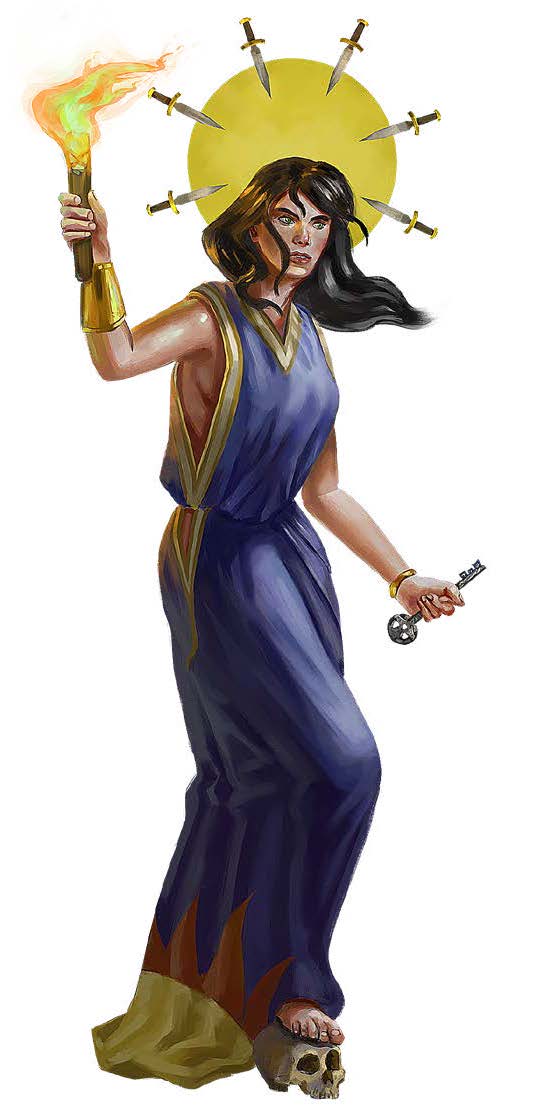
The Midgard Worldbook already details a score of saints dedicated to the war god Mavros, but the other deities have their share of saints as well. Saints of Midgard uncovers some of these holy personages, including information on their origins, followers, blessings and miracles, and the relics attributed to them.
Saint Ssesmiyra, the Horned Saint
Origins. Ssesmiyra, the Horned Saint of Hecate, was a minotaur who faithfully served the Bringer of Magic for almost 50 years in the Magocracy of Allain despite being ostracized by many within her church for her monstrous appearance and dark moods.
Said to have been a sight to behold with her slate-colored fur, glyph-inscribed horns, and lean, muscular build, Ssesmiyra was born in the Magocracy at the end of the Mage Wars and grew up in its aftermath when the area was still recovering from the turmoil. Most of the minotaurs of the region had previously been the chattel of mages, but with the end of the war, Ssesmiyra and her family were released and struggled for survival on the fringes of society.
In her late teens, Ssesmiyra joined the priesthood of Hecate. Shortly thereafter, she performed her first miracle in the goddess’s service, calling forth a coiling serpent of living shadow to destroy a fellow priest who had been belittling her.
These miracles continued for the length of Ssesmiyra’s life: the priestess given to sudden and violent prophetic visions, often injuring or even killing those present, and wielding magic the likes of which her fellow priests had only ever heard about from ancient wizened texts. Indeed, Ssesmiyra’s command of Hecate’s mysteries was so potent that many believed her to be one of the Lady of Sighs many secret daughters.
At the age of 63, Ssesmiyra received a vision from Hecate to travel to the Theocracy of Kammae Straboli far to the south and with few belongings embarked on her journey. What became of Ssesmiyra is unknown, for she never reached her destination. Most believe that she perished during her journey, but whatever truly happened remains a mystery.
Followers. Most of Ssesmiyra’s followers are minotaurs who also worship Hecate. She has a few human and demi-human followers, but their numbers are barely noticeable in comparison. The exceptions are oracles and seers, who often keep a small shrine to the Horned Saint somewhere in their lodgings.
Ssesmiyra’s most famous followers include the minotaurs’ High Elder Potnia Adrasta and Queen Kitane of Kyprion, both of whom are known to wear small magical cameos, depicting the Horned Saint’s visage.
Blessings and Miracles. Ssesmiyra sometimes manifests as a snake coiled around a minotaur’s horn or similar object. This is typically accompanied by brief visions of future events, warning the recipient of potential danger. The sudden appearance of a bull with slate-colored fur or an empusa (seeTome of Beasts 2) to defend one of Hecate’s shrines or temples is also seen as a sign of Ssesmiyra’s favor.
The vast majority of Ssesmiyra’s miracles are closely guarded secrets of Hecate’s tight-lipped church. However, she was well known for her sibylline abilities and the strange divine magic she often wielded.
Holy Relics
The relics of the saints are items of renown and power, vitally important to those of the same faith and zealously sought after and guarded.
CAMEO OF THE HORNED SAINT
Wondrous item, very rare (requires attunement)
These protective items appear as small circular disks of polished red chalcedony with Ssesmiyra’s image embedded in pure ivory. They are popular items amongst Ssesmiyra’s faithful.
While you are attuned to this cameo, you gain a +1 bonus to saving throws and can cause a ghostly white minotaur to manifest from the cameo once per day. This minotaur has the same abilities as the guardian of faith spell. The cameo recharges at dawn.
HORN OF SAINT SSESMIYRA
Wondrous item, legendary (requires attunement)
Said to have appeared in the hands of Hecate’s faithful shortly after Ssesmiyra mysteriously vanished on her way to Kammae Straboli, this minotaur horn is etched with spiraling patterns chased in gold and silver, and it bears a short onyx grip where it would be attached to the skull. To attune to the horn, you must place it against your forehead. Doing so causes it to magically merge with your skull until you decide to remove it. If you are already a creature with horns (such as a minotaur), this horn magically replaces one of your own until removed.
While you are attuned to this horn, you gain some of the racial abilities of a minotaur, including darkvision to 60 feet and a minotaur’s Labyrinth Sense (see Midgard Heroes Handbook). If you are already a minotaur, your darkvision increases to 90 feet, and when you make a charge attack, your horns are counted as magical weapons and deal an additional 1d4 necrotic damage.
Once per day, you can also cause the horn to evoke the effects of a maze spell. Any creature caught within the spell has disadvantage on its Intelligence checks to escape. Unlike the standard version of the spell, it can also affect minotaurs and other creatures who would normally automatically succeed against its effects. In this case, however, they do not suffer disadvantage on their Intelligence checks. This power of the horn recharges at dawn.

“Ssesmiyra,” pronunciation please?
I’m thinking that’s not a picture of Ssesmiyra.
That’s Hecate. We’ve been using each god’s illustration for this series.
The first syllable rhymes with yes but with a longer s sound at the start (making that classic hissing snake sound). The second part of the name sounds like Meera.
Hope that helps.
Very helpful thank you😎
That’s a picture of Hecate. I believe it’s from the Midgard Worldbook.